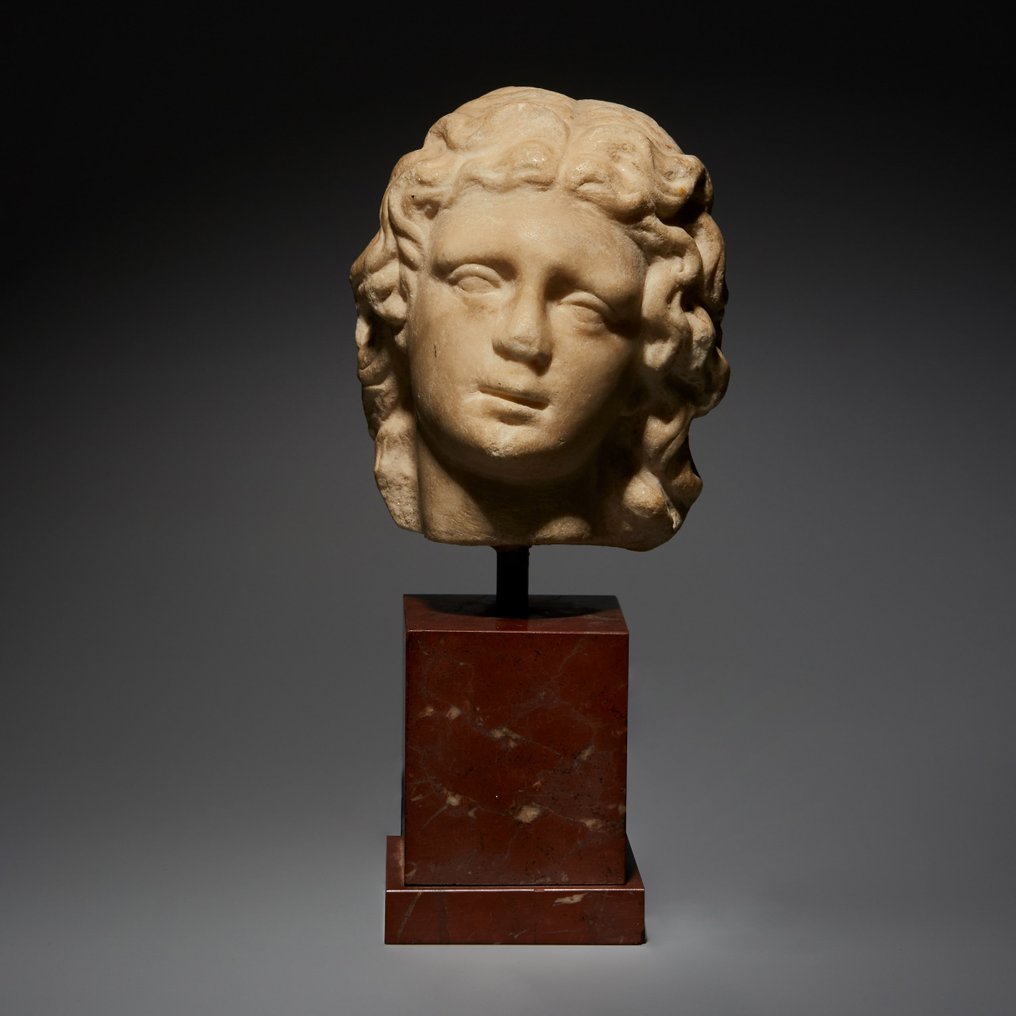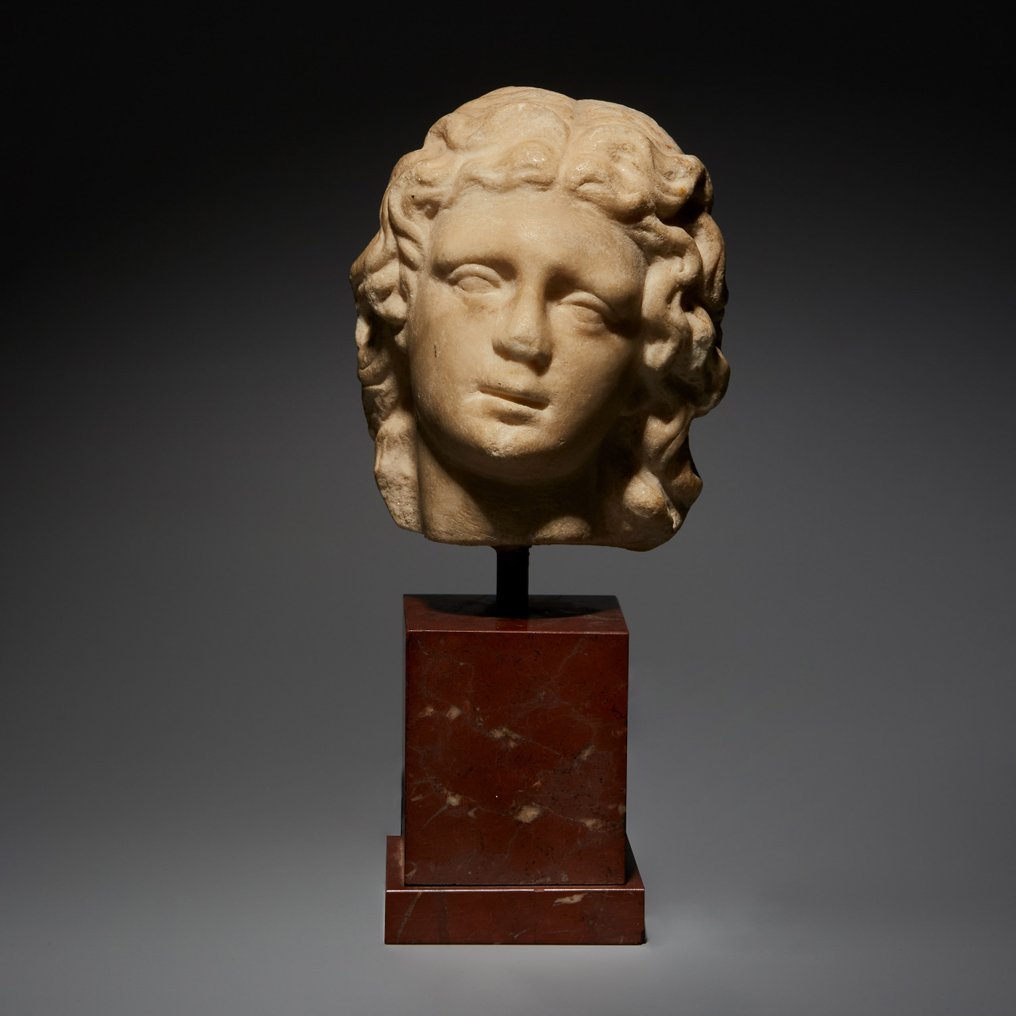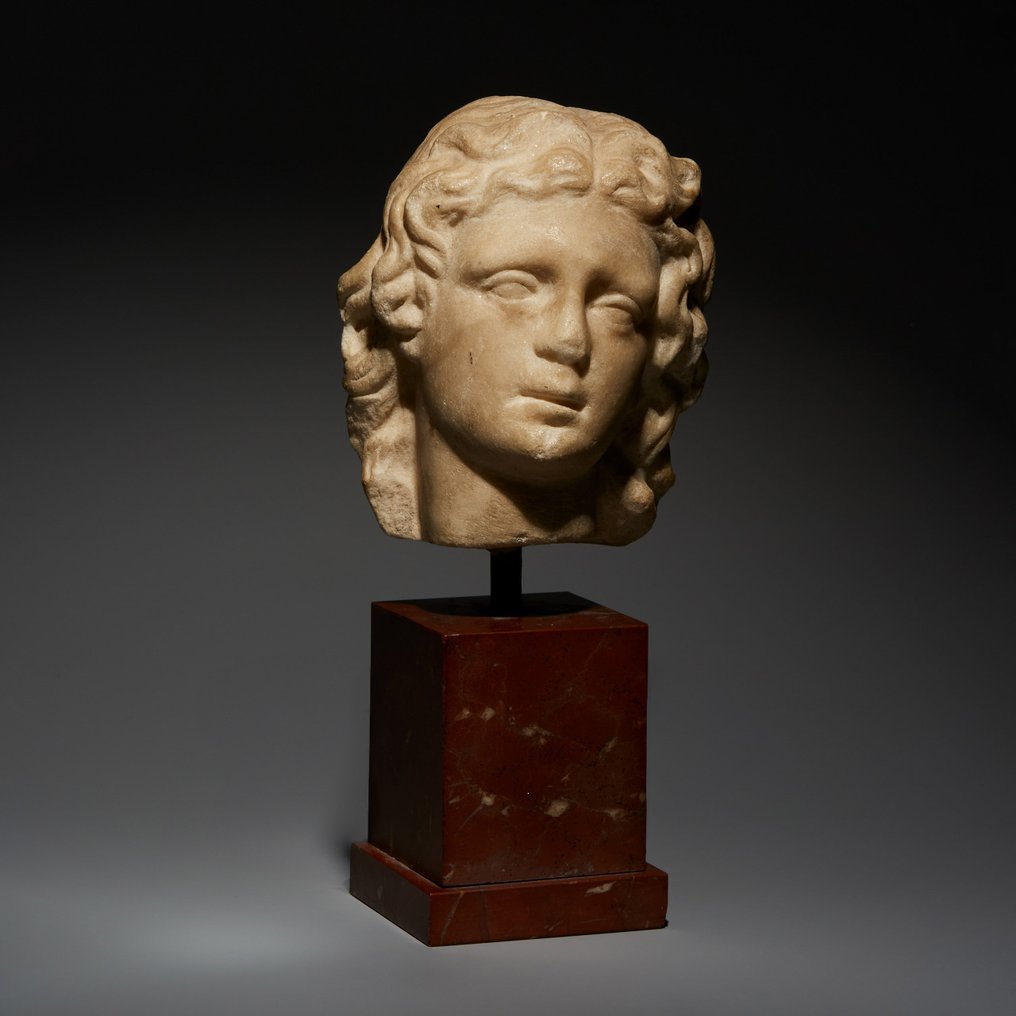merci, jolie bijou.
Fordítás megtekintéseÓkori római Márvány Amazon Head. Kr.u. 1. - 2. század. 11,5 cm magas.
Nr. 88998701



Amazon Head
Ancient Roman, 1st - 2nd century AD.
Marble.
11.5 cm height.
Condition: Good state of conservation, without restorations. There is a scratch on the chin and a slight missing piece of hair on the back right.
Provenance: Private collection, Doullens, France, 1970 – 1908.
Description:
Head carved in marble in a round shape belonging to a sculpture of less than life size, about 90 cm in total height. It represents a youthful female face that follows the iconography of the wounded Amazon, developed from the models that Polycletus, Phidias, Cresilas and two other unknown sculptors, Cydon and Phradmon, created for the temple of Artemis in Ephesus around 440 BC. (fig. 1). Having lost strength, the head tilts to the left, the thick-lidded eyes narrow and the mouth relaxes and opens slightly, evoking a panting breath. The elegant languor of the figure, its expressive restraint and the grace of gesture and movement reveal the influence of classical Greek models, especially current in Roman art of the 1st and 2nd centuries AD. In Naples, an Amazon head very similar in expression is preserved, derived directly from Greek models from the 5th century BC. (fig. 2).
The carving is delicate and precise, with a facial modeling that balances idealization and naturalism in its combination of fluid lines, delicately curved on the cheeks, jaw, chin and neck, and a gently frowning brow that provides a content but expressive drama to the representation, characteristic of the Greek models of the second half of the 5th century BC. The loose and wavy hair frames the face, providing a dynamic play of contrast of light and shadow, and is worked with thick independent strands, moved and volumetric around the face and flatter, although equally individualized, on the back of the head. head.
In Greek mythology, the Amazons were a race of warriors and hunters, daughters of Ares and worshipers of Artemis. They lived, literally and symbolically, on the margins of the human world. Located by ancient Greek legends in Asia Minor, the steppes around the Black Sea or even Libya, were conceived as the embodiment of the wild, the opposite of civilization. That is why they generally appear in mythical narratives as opponents of the Greeks: the Amazon queen Penthesilea faced Achilles in a duel during the Trojan War, and her sister, Hippolyta, fought against Hercules in one of his twelve labors. . The theme of the Amazonomachy, the battle between men and Amazons as a symbolic confrontation between civilization and barbarism, was a frequent iconographic theme in Greece and also in Rome; It appears in the Treasury of the Athenians at Delphi and on the altar of Zeus in Pergamon, although perhaps the most important example is the series of metopes that Phidias made for the Parthenon in Athens.
Brave, brave and fearsome, the Amazons carried out military expeditions to the most distant corners of the world, from Scythia to Egypt, and were also considered founders of temples and ancient cities such as Ephesus or Smyrna. They had no relationship with men other than what was strictly necessary to reproduce, and they raised only the girls, returning the boys to their fathers. The discovery of tombs of warrior women in the Eurasian steppe suggests that the myth of the Amazons could be based on the encounters of the Greeks with queens and warriors of the nomadic horsemen people of the area - Scythians, Sarmatians and Hittites.
Bibliography:
- BOTHMER, D. von. Amazons in Greek Art. Oxford University Press. 1957.
- GRIMAL, P. The Dictionary of Classical Mythology. Wiley-Blackwell. nineteen ninety six.
- KLEINER, D.E. Roman Sculpture. Yale University Press. 1992.
Parallels:
Fig. 1 Wounded Amazon. Roman copy of the s. I AD from a Greek original from the 19th century. V BC Marble, 195 cm high. Ny Carlsberg Glyptotek, Copenhagen, inv. 1658.
Fig. 2 Wounded Amazon head. Roman copy of the s. I AD from a Greek original from the 19th century. V BC Marble, 31 cm high. Museo Archeologico Nazionale di Napoli (Italy), inv. 15041.
Notes:
The piece includes authenticity certificate.
The piece includes Spanish Export License.
Az eladó története
Amazon Head
Ancient Roman, 1st - 2nd century AD.
Marble.
11.5 cm height.
Condition: Good state of conservation, without restorations. There is a scratch on the chin and a slight missing piece of hair on the back right.
Provenance: Private collection, Doullens, France, 1970 – 1908.
Description:
Head carved in marble in a round shape belonging to a sculpture of less than life size, about 90 cm in total height. It represents a youthful female face that follows the iconography of the wounded Amazon, developed from the models that Polycletus, Phidias, Cresilas and two other unknown sculptors, Cydon and Phradmon, created for the temple of Artemis in Ephesus around 440 BC. (fig. 1). Having lost strength, the head tilts to the left, the thick-lidded eyes narrow and the mouth relaxes and opens slightly, evoking a panting breath. The elegant languor of the figure, its expressive restraint and the grace of gesture and movement reveal the influence of classical Greek models, especially current in Roman art of the 1st and 2nd centuries AD. In Naples, an Amazon head very similar in expression is preserved, derived directly from Greek models from the 5th century BC. (fig. 2).
The carving is delicate and precise, with a facial modeling that balances idealization and naturalism in its combination of fluid lines, delicately curved on the cheeks, jaw, chin and neck, and a gently frowning brow that provides a content but expressive drama to the representation, characteristic of the Greek models of the second half of the 5th century BC. The loose and wavy hair frames the face, providing a dynamic play of contrast of light and shadow, and is worked with thick independent strands, moved and volumetric around the face and flatter, although equally individualized, on the back of the head. head.
In Greek mythology, the Amazons were a race of warriors and hunters, daughters of Ares and worshipers of Artemis. They lived, literally and symbolically, on the margins of the human world. Located by ancient Greek legends in Asia Minor, the steppes around the Black Sea or even Libya, were conceived as the embodiment of the wild, the opposite of civilization. That is why they generally appear in mythical narratives as opponents of the Greeks: the Amazon queen Penthesilea faced Achilles in a duel during the Trojan War, and her sister, Hippolyta, fought against Hercules in one of his twelve labors. . The theme of the Amazonomachy, the battle between men and Amazons as a symbolic confrontation between civilization and barbarism, was a frequent iconographic theme in Greece and also in Rome; It appears in the Treasury of the Athenians at Delphi and on the altar of Zeus in Pergamon, although perhaps the most important example is the series of metopes that Phidias made for the Parthenon in Athens.
Brave, brave and fearsome, the Amazons carried out military expeditions to the most distant corners of the world, from Scythia to Egypt, and were also considered founders of temples and ancient cities such as Ephesus or Smyrna. They had no relationship with men other than what was strictly necessary to reproduce, and they raised only the girls, returning the boys to their fathers. The discovery of tombs of warrior women in the Eurasian steppe suggests that the myth of the Amazons could be based on the encounters of the Greeks with queens and warriors of the nomadic horsemen people of the area - Scythians, Sarmatians and Hittites.
Bibliography:
- BOTHMER, D. von. Amazons in Greek Art. Oxford University Press. 1957.
- GRIMAL, P. The Dictionary of Classical Mythology. Wiley-Blackwell. nineteen ninety six.
- KLEINER, D.E. Roman Sculpture. Yale University Press. 1992.
Parallels:
Fig. 1 Wounded Amazon. Roman copy of the s. I AD from a Greek original from the 19th century. V BC Marble, 195 cm high. Ny Carlsberg Glyptotek, Copenhagen, inv. 1658.
Fig. 2 Wounded Amazon head. Roman copy of the s. I AD from a Greek original from the 19th century. V BC Marble, 31 cm high. Museo Archeologico Nazionale di Napoli (Italy), inv. 15041.
Notes:
The piece includes authenticity certificate.
The piece includes Spanish Export License.
Az eladó története
- 824
- 9
- 1
Ik heb het goed en snel ontvangen. Het ziet er goed uit. Ben er blij mee.
Fordítás megtekintéseGreat seller!!
Fordítás megtekintéseBagot siempre rápido y fiable, muchas gracias
Fordítás megtekintésegreat scarab! very fast shipping! thank you very much!
Fordítás megtekintéseTodo bien. Vendedor recomendado.
Fordítás megtekintéseAbsolut vertrauenswürdiger Händler ! Und: ein ganz zauberhaftes Stück !
Fordítás megtekintéseOttimo imballo particolare come da foto
Fordítás megtekintéseTodo bien. Persona muy amable y atenta. Recomendado.
Fordítás megtekintéseTodo bien. Vendedor muy amable y atento. Recomendado.
Fordítás megtekintéseTodo bien. Persona muy amable y atenta. Vendedor recomendado.
Fordítás megtekintéseTodo bien. Envío muy cuidado, de auténtico profesional. Persona, además, muy amable y atenta. Vendedor recomendado.
Fordítás megtekintésea recommander envoi tres rapide est sécurisé embalage tres bien fait vraiment rien a dire plus que parfait
Fordítás megtekintéseBeautiful objects! Extremely fast shipment! I can fully recommend this seller.
Fordítás megtekintésewonderful apis!very fast shipping!thanks a lot
Fordítás megtekintésepezzo bellissimo, e spedito a tempo record, venditore veloce onesto e preciso, consigliatissimo. Grazie
Fordítás megtekintéseAlways a great pleasure !
Fordítás megtekintéseEnvíos siempre con cuidado
Fordítás megtekintéseBuen vendedor
Fordítás megtekintéseObjekte wie abgebildet, das Gefäss sogar noch schöner / unkomplizierter Versand und sehr gut verpackt. Perfekte Transaktion!!
Fordítás megtekintésesuperb, as usual
Fordítás megtekintéseGreat object, fast delivery
Fordítás megtekintéseProfessional seller. Object received s described. Fair price
Fordítás megtekintéseTodo ok
Fordítás megtekintéseWell packed, fast delivery. Arrived safely, in good condition. Thank you!
Fordítás megtekintéseLemondás
Az eladó garantálja, hogy a tárgy a jogszabályoknak megfelelően került hozzá, és ezt bizonyítani is tudja. Az eladó kapott információt a Catawikitől arról, hogy a tárgyhoz mellékelnie kell a tartózkodási helyének megfelelő jogszabályok alapján szükséges dokumentációt. Az eladó garantálja a tárgy eladását/exportját és jogában áll mindez. Az eladó minden a tárggyal kapcsolatban szükséges információt továbbít a vevőnek. Az eladó biztosítja, hogy minden szükséges engedély el lett/lesz intézve. Az eladó azonnal tájékoztatja a vevőt, amennyiben az engedélyek beszerzése késik.
Az eladó garantálja, hogy a tárgy a jogszabályoknak megfelelően került hozzá, és ezt bizonyítani is tudja. Az eladó kapott információt a Catawikitől arról, hogy a tárgyhoz mellékelnie kell a tartózkodási helyének megfelelő jogszabályok alapján szükséges dokumentációt. Az eladó garantálja a tárgy eladását/exportját és jogában áll mindez. Az eladó minden a tárggyal kapcsolatban szükséges információt továbbít a vevőnek. Az eladó biztosítja, hogy minden szükséges engedély el lett/lesz intézve. Az eladó azonnal tájékoztatja a vevőt, amennyiben az engedélyek beszerzése késik.









